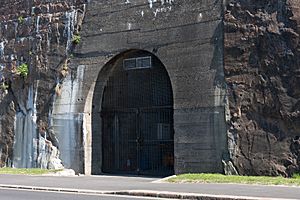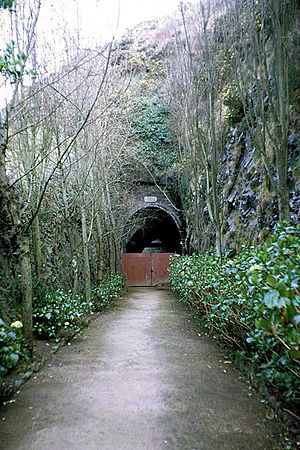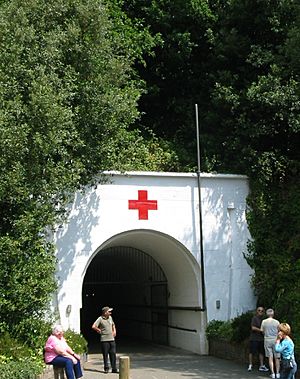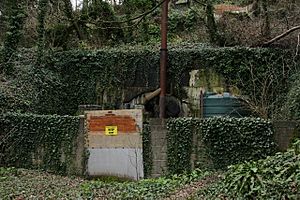Hohlgangsanlage tunnels, Jersey facts for kids
Quick facts for kids Hohlgangsanlagen |
|
|---|---|
| German Tunnels | |
| Part of Atlantic Wall | |
| Jersey | |
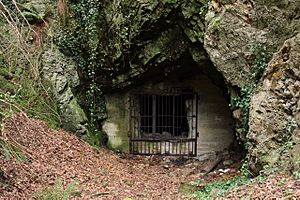
The northernmost entrance to Ho2 in St. Peter
|
|
 
Flag of the German occupying forces
|
|
| Site information | |
| Owner | Owner of land above tunnel |
| Controlled by | States & private ownership |
| Open to the public |
One open to the public, others can be visited with land owners permission. |
| Condition | One fully restored, others maintained, most abandoned |
| Site history | |
| Built | 1941–1945 |
| Built by | Festungsbaubataillone, 4/Gesteinsbohr-Kompanie Btl. 77, Reichsarbeitsdienst, Organisation Todt, various contractors German and local |
| Materials | Concrete, steel, and timber |
| Demolished | Some (by both Germans and British) |
| Events | German occupation of the Channel Islands |
Hohlgangsanlage (say "HOLE-gangs-an-LAH-guh") are a series of tunnels built on the island of Jersey. German forces constructed these tunnels during their occupation of Jersey in World War II. The main purpose of these underground spaces was to protect soldiers and equipment from air attacks. They also served as strong fortifications.
The name Hohlgangsanlage means "cave passage installations" in German. These tunnels in the Channel Islands are the only ones along the entire Atlantic Wall (a huge defense line built by Germany) that are called by this name.
Most of the tunnels were never fully finished. However, even the partly built ones are very large. The completed parts were used for different things, like storing supplies. By 1944, a huge amount of rock, about 244,000 cubic meters, had been dug out for tunnels in Jersey, Guernsey, and Alderney. Most of this was from Jersey. To give you an idea, this was more rock than had been dug out for the entire rest of the Atlantic Wall, from Norway to France, at the same time!
Contents
Building the Tunnels: 1941 to Today
Why and When the Tunnels Were Built
Construction of the tunnels started in 1941. This was just before Adolf Hitler ordered that the Channel Islands be strongly defended. The tunnels were placed in important spots around Jersey. Most were meant to be shelters or storage areas. Some were also part of larger forts, like those at Corbière, and included casemates (armored structures for guns).
Different groups built the tunnels. These included German army construction battalions, specialist mining teams, and the RAD (a state labor service for young Germans). The Organisation Todt, a German engineering group, also played a big role. The Germans used many types of workers, including forced laborers.
After Albert Speer took over from Todt in 1942, fewer resources were sent to Jersey for tunnel building. By 1944, there was a shortage of building materials. So, efforts focused only on finishing the tunnels that were closest to completion. When Jersey was freed on May 9, 1945, all construction stopped.
How the Tunnels Were Used (and Not Used)
Only a few tunnels were actually used by the Germans. These were Ho1, Ho4, Ho5, and Ho8. Only Ho5 was fully completed. The others were used even though they were still partly built. Unfinished parts were sometimes walled off or left with wooden supports.
After the war, the British military used some of the tunnels. They stored military equipment there. For example, Ho1 held weapons, and Ho2 stored smaller items like helmets, gas masks, and fuel. Ho13 even stored tanks!
What Happened to the Tunnels After the War
In the 1950s, most tunnels were emptied and sealed up. This was part of a big effort to collect scrap metal. In Jersey, the person who owns the land also owns everything beneath it. So, all the tunnels are privately owned.
Ho8 is the only tunnel that is regularly open to the public as a museum. The British army opened it in 1946. It was later given to the States of Jersey (the island's government). After a legal case, it became privately owned but still runs as a museum today.
After 1962, most tunnels were completely cleared of German equipment. This happened after two people died from carbon monoxide poisoning in Ho2 while looking for souvenirs. Ho1, Ho4, and the museum (Ho8) were exceptions.
Many people think the tunnels were dug into solid rock like granite. But most were actually dug into loose shale. This means they can be unstable. You can see this from the many roof collapses in the unfinished tunnels that were not lined with concrete. Most tunnels still exist today. Organized groups can visit them with permission. There were even plans to use some tunnels during a Swine flu pandemic, but thankfully, it didn't happen.
How the Tunnels Were Built and Designed
Digging into the Earth
The tunnels were dug into the sides of hills, directly into the rock. This is why many unfinished tunnels are still mostly intact. The rock itself provides support. Completed sections have concrete floors, walls, and ceilings.
There were two main designs: one for storage and one for people. Storage tunnels had a narrow railway track (600 mm wide) that looped around the whole complex. They also had a small platform for loading supplies. These tunnels usually had two entrances, so vehicles could easily drive in and out. Tunnels for people were built more like a grid. The railway was often removed once construction was finished.
When completed, the tunnels would have had concrete linings, drainage systems, lighting, and air conditioning. About 19 to 25 storage tunnels were planned. However, many records were destroyed before the Germans surrendered, so the exact number is not known. We do know how many were started.
Choosing the Right Rock
Wherever possible, the tunnel builders avoided hard granite. Instead, they dug through softer shale rock. This made construction faster and needed less effort. However, it was also more dangerous because there was a higher risk of rockfalls.
The tunnels were dug using a traditional method: drilling holes and then blasting the rock with explosives. Once the tunnels were dug out, they were lined with concrete. First, the floor was lined, then the walls, and finally the roof. Wooden frames were used to hold the concrete for the walls and roof. Concrete was poured into the space between the frames and the rock.
Interestingly, concrete was often poured down special shafts from above, not through the tunnel entrances. This kept the concrete clean and prevented it from mixing with the rock being removed from the tunnel. You can still see these chutes in many tunnels today.
While there were not many accidents during the building work itself, many forced laborers died from the very harsh conditions.
Key Tunnels in Jersey
Storage Tunnels: Keeping Supplies Safe
These tunnels were mainly used for storing goods.
- Ho1 – A munitions (weapons) store. It's on the west side of La Route d'Aleval. It was incomplete but used, and later became a mushroom farm.
- Ho2 – A ration (food) store. It's on the east side of La Route d'Aleval. It was incomplete.
- Ho4 – Another munitions store. It's on the west side of Grand Vaux Valley. It was incomplete but used, and is now used by Jersey Water for storage.
- Ho5 – A fuel store in St. Aubin, along the Railway Walk. This tunnel was completed and used for munitions. The States of Jersey use it today.
- Ho8 – Originally planned for artillery quarters, this tunnel in St Peter's Valley was incomplete but turned into a hospital. Today, it's a popular visitor attraction known as the Jersey War Tunnels.
- Ho19 – An electricity works tunnel. Its first entrance is from La Folie, St Helier. It was incomplete and is now used by the States of Jersey.
Railway Tunnels: Moving Things Underground
Only one main railway tunnel was designed just for trains:
- Eastern Railway Connecting tunnel – This incomplete tunnel connects under Mount Bingham in St Helier. It is now used by the Jersey Electricity Company (JEC).
Fortified Tunnels: Strongholds and Defenses
These tunnels were either standalone or part of larger defense structures.
- Ho Etaquerel – A completed casemate (gun bunker) complex at L'Etacq, St. Ouen.
- Ho Mole Verclut – A completed casemate complex at Verclut Point. It's now used by Jersey Turbot (a fish farm).
- Stützpunkt Corbiere – A completed communications tunnel that linked different bunkers at La Corbiere. These bunkers are open to the public through the Channel Islands Occupation Society (CIOS).
- Batterie Moltke – A completed gun battery with its own tunnel system at Les Landes Common, St Ouen. This site is also open to the public by CIOS.
|
See also



